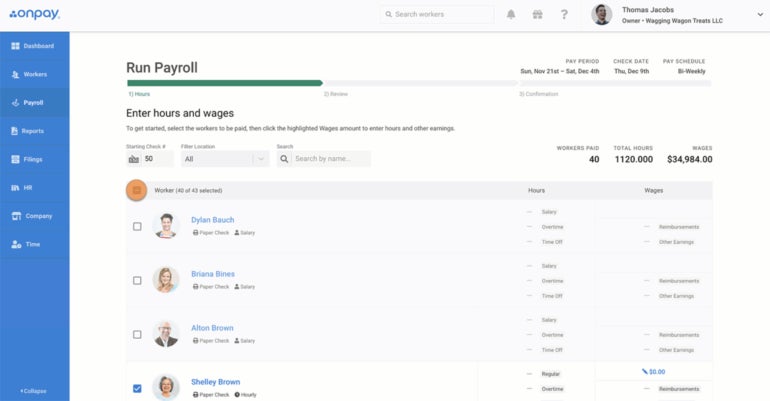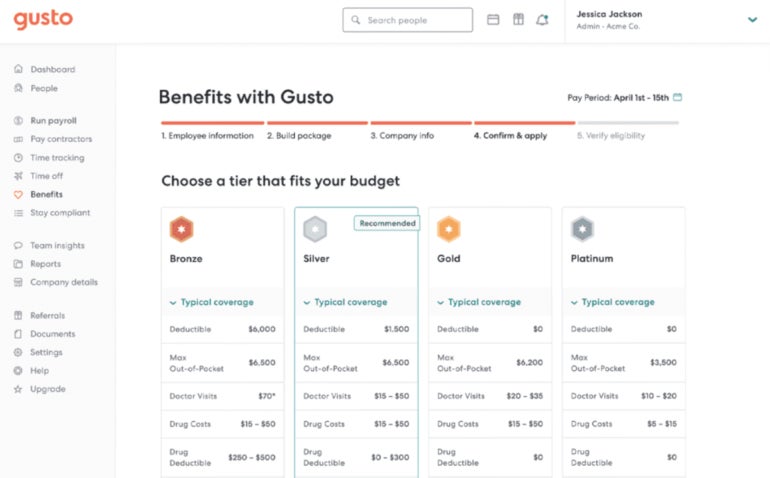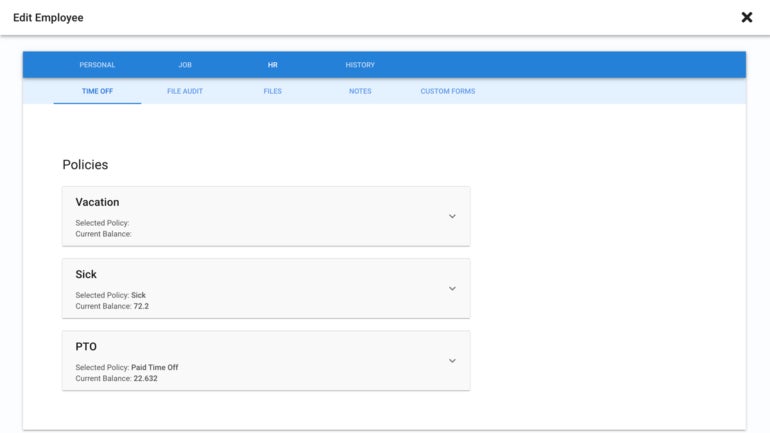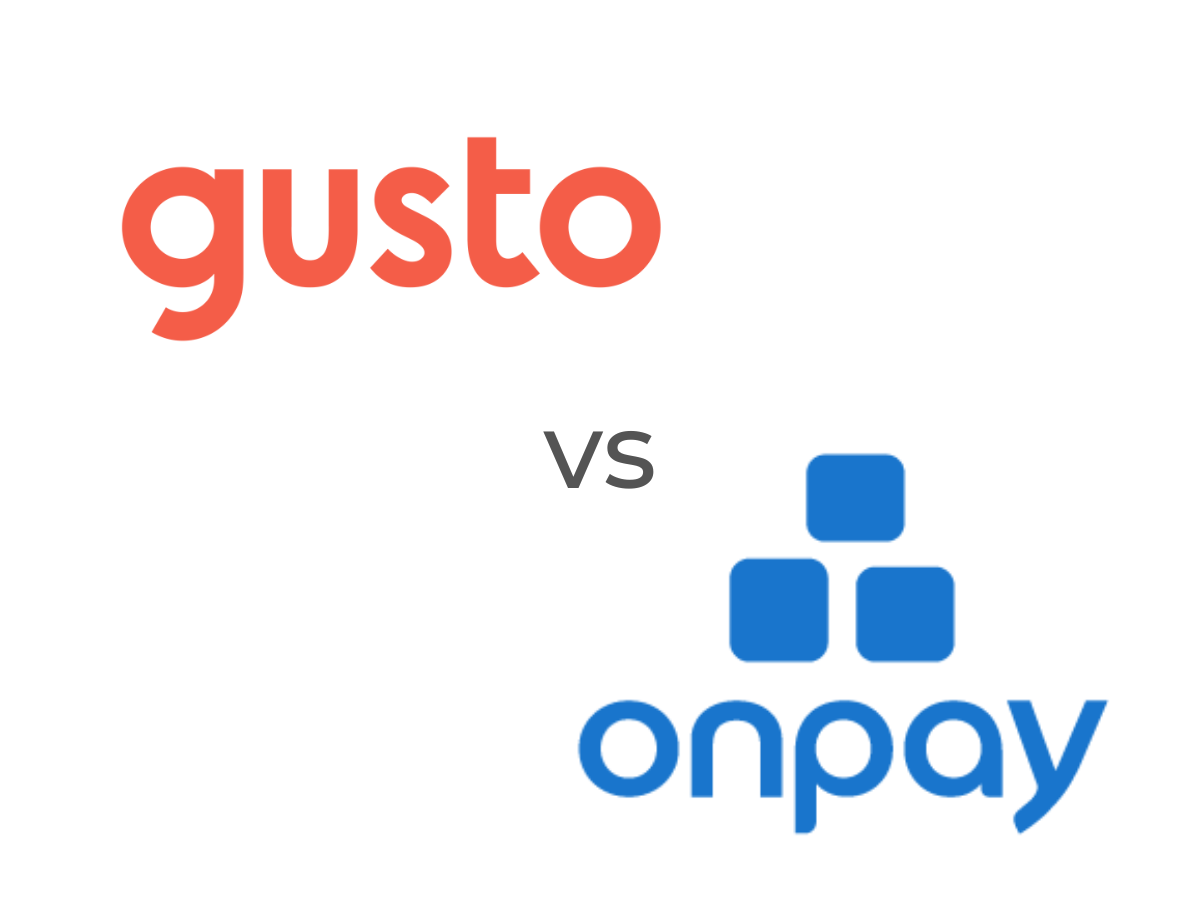Gusto and OnPay are frequently recommended as affordable payroll software for small businesses. They offer some similar features, and their entry-level pricing plans are even exactly the same.
However, on closer inspection, these two payroll platforms turn out to be quite different from each other. In this Gusto vs. OnPay review, we compare and contrast the two platforms to help you decide on the best one for your business.
Featured Partners: Payroll Software
Gusto vs. OnPay: Comparison table
| Gusto | OnPay | |
|---|---|---|
| Starting price | $40/mo. + $6/person/mo. | $40/mo. + $6/person/mo. |
| Unlimited payroll runs | Yes | Yes |
| Automatic payroll | Yes | No |
| Benefits administration | Yes | Yes |
| PTO management | Yes | Yes |
| Time tracking and timesheets | Yes | No |
| Talent management | Yes | No |
| Document management | Yes | Yes |
| Integrations | 190+ | 11 |
| Try Gusto | Try OnPay |
Gusto vs. OnPay: Pricing
Gusto
Gusto offers multiple pricing plans to choose from, including a contractor-only plan:
- Simple: $40 per month plus $6 per person per month.
- Plus: $80 per month plus $12 per person per month, with the option to add HR and priority support for $8 per person per month.
- Premium: Custom quote.
- Contractor: $35 per month plus $6 per contractor per month (Gusto will waive the $35 fee for the first six months).
If you want to see how Gusto works before committing, you can create an account for free to test the software. You won’t be charged for services until you run payroll for the first time.
To learn more, check out our Gusto review or our other software comparisons:
OnPay
OnPay offers a single monthly pricing plan: a $40 base fee, plus $6 per person per month — no hidden fees or add-ons. This single, transparent pricing is great for small businesses on a budget, but may not offer a lot of scalability for growing companies.
To learn more, check out our OnPay review or our other software comparisons:
Gusto vs. OnPay: Feature comparison
Payroll
Gusto is known for its easy-to-use, automated payroll, which sets it apart from many Gusto competitors. It offers unlimited payroll runs, so you won’t be charged extra if you want to run more frequent payrolls. If you want to fully automate your payroll, you can enable the AutoPilot feature, which will run payroll one day before your payroll deadlines. It also calculates your payroll taxes for you and automatically files them with the appropriate government agency.
OnPay can process payroll in just a few clicks (Figure A), but it does not offer fully automated payroll. However, it does support unlimited payroll runs, similar to Gusto. OnPay lets you set multiple pay rates and schedules, and pay workers by direct deposit, debit card or check. OnPay will also handle all federal, state and local taxes on your behalf and will generate online I-9 and W-4 forms.

Benefits administration
Gusto’s benefits administration system (Figure B) includes more than 9,000 health insurance plans across 30+ carriers. Add on vision and dental and a 401(k) plan, or use the broker integration to sync your already existing plans. You can also manage workers’ comp, HSA and FSA accounts and even commuter benefits all within the Gusto platform.

OnPay offers health and dental benefits in all 50 states, and companies can access most major medical insurance providers within the software, including Cigna, Humana and Blue Cross Blue Shield. OnPay offers support for HSA and FSA accounts in addition to integrated 401(k) retirement plans and workers’ comp, and you can choose to add on life, vision, disability and other policies as well.
Time and attendance
Gusto offers much more robust time and attendance features, although you’ll need to upgrade to the Plus plan to get them. Team members can clock in and out or log hours after the fact with the web app, the mobile app, the Time Kiosk or geo-fenced work sites. Even if your employees aren’t hourly, they can still track time by project to help you identify time sucks and roadblocks. You can automate PTO management with approval workflows, balance calculations and payroll and calendar syncing.
In contrast, OnPay’s time management features are quite simple and mostly focused on PTO management (Figure C). You can set customized accrual policies, and employees can submit PTO requests in the tool. Once approved, the PTO data syncs to payroll automatically. However, for more timesheet features, you will need to rely on a third-party integration.

Talent management
Talent management is another area where Gusto surpasses OnPay. The Gusto Plus plan gives users access to an applicant tracking system as well as customizable offer templates. This plan also includes a performance review module (Figure D), which covers self evaluations and manager evaluations as well as career development resources and process management and tracking.
OnPay does not offer any similar talent management features, which is one reason why you might seek out OnPay competitors and alternatives like Gusto.

Onboarding and document management
Both Gusto and OnPay provide onboarding checklists as well as document signing and storage to get new hires started faster. Store all kinds of employee documents in these digital file cabinets, including tax forms and pay stubs. Gusto includes a library of pre-built templates, such as offer letters and NDA forms, which you can also customize and save.
OnPay lets you create and save custom templates but doesn’t provide a library of pre-built templates (though it will help you generate an offer letter).
Reporting
Gusto includes almost 25 pre-built reports as well as the ability to generate your own custom reports. Meanwhile, OnPay comes with seven pre-built reports and limited customization options. While neither of their reporting offerings are as robust as some of their competitors (such as BambooHR), Gusto does include more pre-built reporting options.
Integrations
Integrations are another major difference between Gusto and OnPay. Gusto offers more than 190 integrations across multiple app categories, such as accounting, business operations and learning management. Meanwhile, OnPay only offers 11 integrations, and three of those are QuickBooks. Thus, you have a much higher chance of finding the integrations that you need with Gusto than with OnPay.
Gusto pros and cons
Pros of Gusto
- Automatic payroll and unlimited payroll runs.
- Time and attendance features.
- Recruiting and talent management tools.
- Almost 200 integrations available.
Cons of Gusto
- Must upgrade to a more expensive pricing plan to access many features.
- May be too complex for some small businesses.
- No compensation management included.
- QuickBooks integration could be improved.
OnPay pros and cons
Pros of OnPay
- One single transparent pricing plan.
- Offers unlimited monthly pay runs.
- Benefits administration in all 50 states.
- Integrated PTO management.
Cons of OnPay
- HR features aren’t as comprehensive as Gusto.
- No automatic payroll option.
- No built-in time tracking feature.
- Lacks talent management features.
Should your organization use Gusto or OnPay?
Choose Gusto if . . .
- You need automatic payroll.
- You are willing to pay more for more comprehensive HR features.
- You need more comprehensive timesheets and time tracking.
- You want talent management features like recruiting and performance management.
- You want a wide selection of integrations to choose from.
Choose OnPay if . . .
- You are on a budget and want a single transparent pricing plan.
- You don’t want fully automated payroll.
- You are fine using a different tool for time tracking and timesheets.
- You don’t need talent management features.
- You can make do with a much smaller number of integrations.
Methodology
To compare Gusto and OnPay, we considered features such as unlimited payroll runs, automated payroll, benefits administration, time and attendance, talent management, onboarding, document management and integrations. We also weighed factors such as pricing, user interface design and customer service. And we evaluated product documentations and user reviews during the writing of this review.


